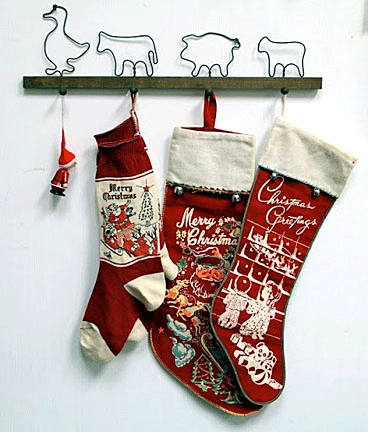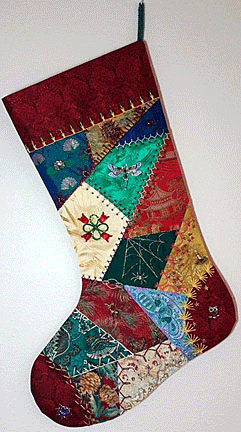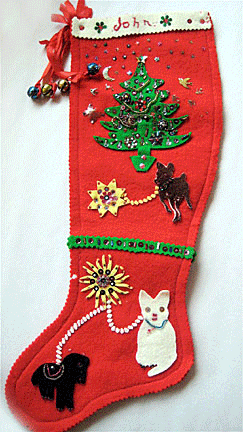|
And the Stockings Were Hung by the
Chimney with Care
QUESTION:
 When
I was a kid, I used to get so excited hanging a stocking with my
name on it on our stair railing on Christmas Eve. We didn’t have a
fireplace, so no mantel. When I became an adult, I used to see
handmade Christmas stockings at church bazaars and at yard sales and
began to buy the ones I liked the most. Now I have quite a
collection. During the holidays, I hang some of them on the railing
of the stairway and other locations in my house. But how did this
custom get started? And are Christmas stockings good collectibles? When
I was a kid, I used to get so excited hanging a stocking with my
name on it on our stair railing on Christmas Eve. We didn’t have a
fireplace, so no mantel. When I became an adult, I used to see
handmade Christmas stockings at church bazaars and at yard sales and
began to buy the ones I liked the most. Now I have quite a
collection. During the holidays, I hang some of them on the railing
of the stairway and other locations in my house. But how did this
custom get started? And are Christmas stockings good collectibles?
Thanks,
Susanna
_________________________________________________________
ANSWER:
 Before
getting into the history of the Christmas stocking
tradition, it’s important to put the collecting of these
stockings in perspective. While people actively followed
this tradition throughout the 19th century, children back
then used their own stockings for the most part. At the
height of the Victorian Era, specially made Christmas
stockings began to appear, often made in crazy quilt designs
using scraps of cloth leftover from making clothes. Before
getting into the history of the Christmas stocking
tradition, it’s important to put the collecting of these
stockings in perspective. While people actively followed
this tradition throughout the 19th century, children back
then used their own stockings for the most part. At the
height of the Victorian Era, specially made Christmas
stockings began to appear, often made in crazy quilt designs
using scraps of cloth leftover from making clothes.
But ordinary children’s stockings couldn’t hold much in the
way of treats—perhaps some fruit and candies. It wasn’t
until the mid-20th century that larger commercially made
Christmas stockings began to appear in stores. However,
those with a craftier bent still made their own stockings
from felt or velvet, decorated with appliques.
Though historical origins of the Christmas stocking exist,
many historians believe its beginnings date back to a legend
involving St. Nicholas. As he was passing through a village,
he heard about a nobleman whose wife had recently died of an
illness, leaving him and his three beautiful daughters in
despair. Devastated by his wife's death, he squandered all
his wealth and property, forcing him and his daughters to
move into a lowly peasant’s cottage. His daughters, each
ready to marry, couldn’t do so because he had no money to
give them dowries.
 St.
Nicholas knew that the father would be too proud to accept
money from him, so he came up with a plan to help him
secretly. One night after the daughters had washed out their
clothing, they hung their stockings over the fireplace to
dry. That night St. Nicholas stopped by the cottage after
the family had gone to bed. He peeked in the window and saw
the daughters' stockings hanging by the fire. St. Nicholas
reached into his pouch and felt three small sacks of gold.
He threw one of them through the window, providing a dowry
for the eldest girl, then provided dowries for the other two
daughters in the same manner on subsequent evenings. St.
Nicholas knew that the father would be too proud to accept
money from him, so he came up with a plan to help him
secretly. One night after the daughters had washed out their
clothing, they hung their stockings over the fireplace to
dry. That night St. Nicholas stopped by the cottage after
the family had gone to bed. He peeked in the window and saw
the daughters' stockings hanging by the fire. St. Nicholas
reached into his pouch and felt three small sacks of gold.
He threw one of them through the window, providing a dowry
for the eldest girl, then provided dowries for the other two
daughters in the same manner on subsequent evenings.
 On
the third evening, the father caught Nicholas throwing the
third sack of gold, and thanked him for his generosity. In
some versions of this story, Nicholas throws the sacks of
gold down the chimney, and they fall into each of the
daughter's stockings, hanging to dry by the fire. This is a
bit implausible since the stockings would have been hanging
above the fire and not anywhere near the chimney opening in
the fireplace. On
the third evening, the father caught Nicholas throwing the
third sack of gold, and thanked him for his generosity. In
some versions of this story, Nicholas throws the sacks of
gold down the chimney, and they fall into each of the
daughter's stockings, hanging to dry by the fire. This is a
bit implausible since the stockings would have been hanging
above the fire and not anywhere near the chimney opening in
the fireplace.
Another interpretation of the stocking custom says that it
began in Germany where children would place their boots,
filled with carrots, straw, or sugar cubes, near the chimney
for the flying horse of a legendary figure named Odin, who
would reward the children for their kindness by replacing
his horse Sleipnir's food with gifts or candy.
 After
the adoption of Christianity in medieval times, Europeans
began honoring St. Nicholas on December 6. In the
Netherlands, Belgium, and Germany, folk traditions developed
around the idea of St. Nicholas bringing treats to children
on St. Nicholas's Eve. Parents told their children to leave
their shoes by the fire on that evening so that the Nicholas
could climb down the chimney and fill them up with fruit,
nuts, and cookies. Some parents substituted stockings for
shoes. After
the adoption of Christianity in medieval times, Europeans
began honoring St. Nicholas on December 6. In the
Netherlands, Belgium, and Germany, folk traditions developed
around the idea of St. Nicholas bringing treats to children
on St. Nicholas's Eve. Parents told their children to leave
their shoes by the fire on that evening so that the Nicholas
could climb down the chimney and fill them up with fruit,
nuts, and cookies. Some parents substituted stockings for
shoes.
Eventually, people moved the tradition of giving gifts to
children from St. Nicholas Day to Christmas. In Germany
children began to hang stockings at end of their beds on
Christmas Eve so that Christkindel or the Christ Child could
fill them with treats as he voyaged from house to house. As
Germans emigrated to America in the 19th century, they
brought the stocking custom with them.

Part of the fun of collecting old and vintage Christmas stockings is in
displaying them during the holidays. While most commercial stockings
aren’t worth very much, collecting them is akin to collecting old
Christmas balls. So as you hang your stocking on the fireplace mantel or
the stairway, think of St. Nicholas.
<
Back to Readers Ask Archives
Next Article > |
